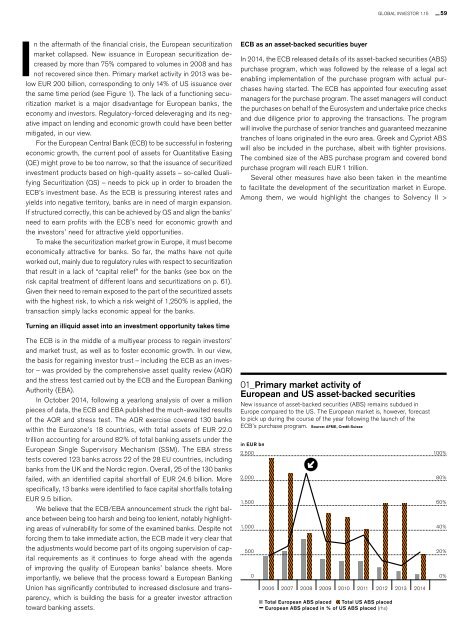Illiquid assets
Unwrapping alternative returns Global Investor, 01/2015 Credit Suisse
Unwrapping alternative returns
Global Investor, 01/2015
Credit Suisse
You also want an ePaper? Increase the reach of your titles
YUMPU automatically turns print PDFs into web optimized ePapers that Google loves.
GLOBAL INVESTOR 1.15 — 59<br />
In the aftermath of the financial crisis, the European securitization<br />
market collapsed. New issuance in European securitization decreased<br />
by more than 75% compared to volumes in 2008 and has<br />
not recovered since then. Primary market activity in 2013 was below<br />
EUR 200 billion, corresponding to only 14% of US issuance over<br />
the same time period (see Figure 1). The lack of a functioning securitization<br />
market is a major disadvantage for European banks, the<br />
economy and investors. Regulatory-forced deleveraging and its negative<br />
impact on lending and economic growth could have been better<br />
mitigated, in our view.<br />
For the European Central Bank (ECB) to be successful in fostering<br />
economic growth, the current pool of <strong>assets</strong> for Quantitative Easing<br />
(QE) might prove to be too narrow, so that the issuance of securitized<br />
investment products based on high-quality <strong>assets</strong> – so-called Qualifying<br />
Securitization (QS) – needs to pick up in order to broaden the<br />
ECB’s investment base. As the ECB is pressuring interest rates and<br />
yields into negative territory, banks are in need of margin expansion.<br />
If structured correctly, this can be achieved by QS and align the banks’<br />
need to earn profits with the ECB’s need for economic growth and<br />
the investors’ need for attractive yield opportunities.<br />
To make the securitization market grow in Europe, it must become<br />
economically attractive for banks. So far, the maths have not quite<br />
worked out, mainly due to regulatory rules with respect to securitization<br />
that result in a lack of “capital relief” for the banks (see box on the<br />
risk capital treatment of different loans and securitizations on p. 61).<br />
Given their need to remain exposed to the part of the securitized <strong>assets</strong><br />
with the highest risk, to which a risk weight of 1,250% is applied, the<br />
transaction simply lacks economic appeal for the banks.<br />
ECB as an asset-backed securities buyer<br />
In 2014, the ECB released details of its asset-backed securities (ABS)<br />
purchase program, which was followed by the release of a legal act<br />
enabling implementation of the purchase program with actual purchases<br />
having started. The ECB has appointed four executing asset<br />
managers for the purchase program. The asset managers will conduct<br />
the purchases on behalf of the Eurosystem and undertake price checks<br />
and due diligence prior to approving the transactions. The program<br />
will involve the purchase of senior tranches and guaranteed mezzanine<br />
tranches of loans originated in the euro area. Greek and Cypriot ABS<br />
will also be included in the purchase, albeit with tighter provisions.<br />
The combined size of the ABS purchase program and covered bond<br />
purchase program will reach EUR 1 trillion.<br />
Several other measures have also been taken in the meantime<br />
to facilitate the development of the securitization market in Europe.<br />
Among them, we would highlight the changes to Solvency II ><br />
Turning an illiquid asset into an investment opportunity takes time<br />
The ECB is in the middle of a multiyear process to regain investors’<br />
and market trust, as well as to foster economic growth. In our view,<br />
the basis for regaining investor trust – including the ECB as an investor<br />
– was provided by the comprehensive asset quality review (AQR)<br />
and the stress test carried out by the ECB and the European Banking<br />
Authority (EBA).<br />
In October 2014, following a yearlong analysis of over a million<br />
pieces of data, the ECB and EBA published the much-awaited results<br />
of the AQR and stress test. The AQR exercise covered 130 banks<br />
within the Eurozone’s 18 countries, with total <strong>assets</strong> of EUR 22.0<br />
trillion accounting for around 82% of total banking <strong>assets</strong> under the<br />
European Single Supervisory Mechanism (SSM). The EBA stress<br />
tests covered 123 banks across 22 of the 28 EU countries, including<br />
banks from the UK and the Nordic region. Overall, 25 of the 130 banks<br />
failed, with an identified capital shortfall of EUR 24.6 billion. More<br />
specifically, 13 banks were identified to face capital shortfalls totaling<br />
EUR 9.5 billion.<br />
We believe that the ECB/EBA announcement struck the right balance<br />
between being too harsh and being too lenient, notably highlighting<br />
areas of vulnerability for some of the examined banks. Despite not<br />
forcing them to take immediate action, the ECB made it very clear that<br />
the adjustments would become part of its ongoing supervision of capital<br />
requirements as it continues to forge ahead with the agenda<br />
of improving the quality of European banks’ balance sheets. More<br />
importantly, we believe that the process toward a European Banking<br />
Union has significantly contributed to increased disclosure and transparency,<br />
which is building the basis for a greater investor attraction<br />
toward banking <strong>assets</strong>.<br />
01_Primary market activity of<br />
European and US asset-backed securities<br />
New issuance of asset-backed securities (ABS) remains subdued in<br />
Europe compared to the US. The European market is, however, forecast<br />
to pick up during the course of the year following the launch of the<br />
ECB’s purchase program. Source: AFME, Credit Suisse<br />
in EUR bn<br />
2,500<br />
2,000<br />
1,500<br />
1,000<br />
500<br />
0<br />
2006 2007 2008 2009 2010 2011 2012 2013 2014<br />
Total European ABS placed Total US ABS placed<br />
European ABS placed in % of US ABS placed (rhs)<br />
100%<br />
80%<br />
60%<br />
40%<br />
20%<br />
0%

















